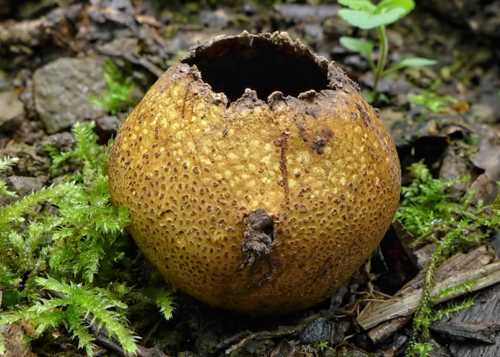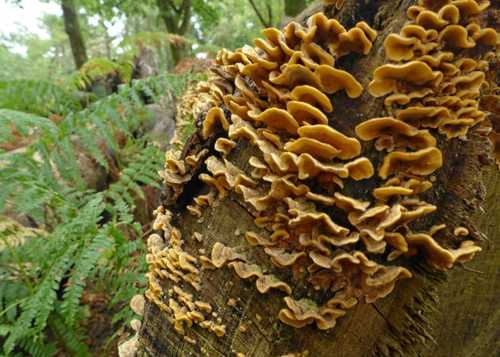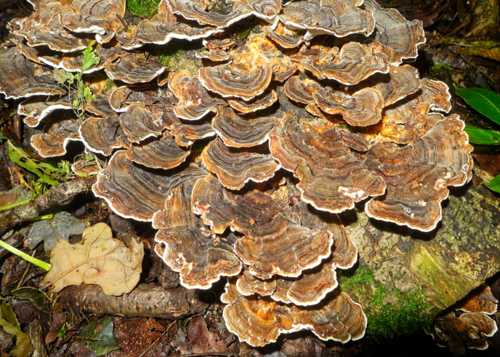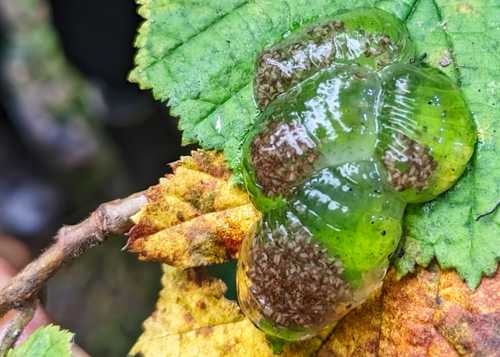above: Fluted Bird’s Nest (Cyathus striatus) © Helena Crouch
Leaders: Alan Rayner and Helena Crouch
Fourteen members assembled at the entrance to Lord’s Wood, just south of Pensford, for an eagerly anticipated fungal foray. Lord’s Wood is located on the Pennant Sandstone of the Upper Coal Measures and thus has areas with acidic soils; it is also a very wet woodland with streams and ponds, and has a variety of different tree species.

Scaly Earthball (Scleroderma verrucosum) © Helena Crouch

Hairy Curtain Crust (Stereum hirsutum) © Helena Crouch
On a log by the entrance, Alan showed us the tiny orange fruitbodies of Common Jelly Spot (Dacrymyces stillatus) and a resupinate fungus, flattened against the log, the Bleeding Conifer Crust (Stereum sanguinolentum) which exudes dark crimson latex when damaged. Entering the wood, we found a dainty Pleated Inkcap (Parasola plicatilis) and a White Fibrecap (Inocybe geophylla) on the verge and a group of Pale Brittlestems (Psathyrella candolleana) on a rotting stump. Scattered small brown toadstools were identified as the Russet Toughshank (Gymnopus dryophilus), with white spores and free gills: we saw this species many times. More numerous on the verges were many fruiting bodies of the Scaly Earthball (Scleroderma verrucosum), some with significant pseudostipes. We found these at all stages of development, including large, split mature ones liberating spores.
A log pile beside the track yielded more treasures. Hairy Curtain Crust (Stereum hirsutum) was abundant on oak logs. On an Ash log we found an array of small white Peeling Oysterlings (Crepidotus mollis) and some old black Cramp Balls, or King Alfred’s Cakes (Daldinia concentrica). Further on, we found a Smoky Bracket (Bjerkandera adusta) on a log. This white rot fungus has a cheesy consistency and a grey surface with tubular pores from which it pours spores! Nearby Alan showed us another wood rotting fungus, causing white fibrous rot, the Cinnamon Porecrust (Phellinus ferreus) with a red-brown pore surface.

Turkeytail (Trametes versicolor) © Helena Crouch

Egg sacs of the Jelly-egg Caddisfly (Glyphotaelius pellucidus) © Helena Crouch
Heading north towards the ponds, we admired a large solitary Whitelaced Shank (Megacollybia platyphylla), with striking mycelial cords which Alan explained will hold it in place like Gulliver in Lilliput … except that mycelial cords are not like ropes, which are composed of bundled threads, but are linear aggregations of hyphae, which themselves are tubes, not threads. Next, we found The Deceiver (Laccaria laccata), a group of Clustered Toughshank (Gymnopus confluens), smart Turkeytail (Trametes versicolor) and a Crab Brittlegill (Russula xerampelina) which amazingly smells of crabs.
Lunch was taken on grassy banks beside the lower pond, and the foray resumed. We found a single old Lilac Bonnet (Mycena pura) smelling of radishes, and a group of Fairy Inkcaps (Coprinellus disseminatus) on a stream bank. Several members stopped to puzzle over some jelly blobs on hazel leaves which were finally identified as the egg sacs of the Jelly-egg Caddisfly (Glyphotaelius pellucidus). Amazingly, the next fungus we found was also a jelly blob: the Crystal Brain (Exidia nucleata), closely related to Witches’ Butter (E. glandulosa) which we had seen earlier in poor condition.
A sharp shower prompted several of the party to head back, but those who continued were rewarded with the most exciting find of the day. On a log beneath brambles, Alan spotted a group of little hairy cups with stripy linings, filled with white eggs. These were Fluted Bird’s Nest (Cyathus striatus). We paid homage to a huge Yew tree, then turned back. The weather had been mostly kind and although there was not a super abundance of fungi, we had seen an interesting selection of species, with more time to study each one.
Helena Crouch


Recent Comments